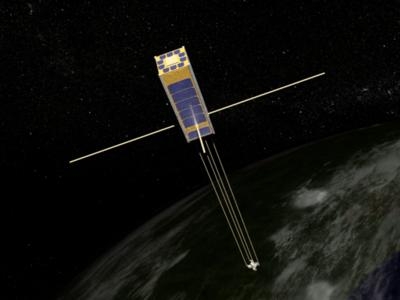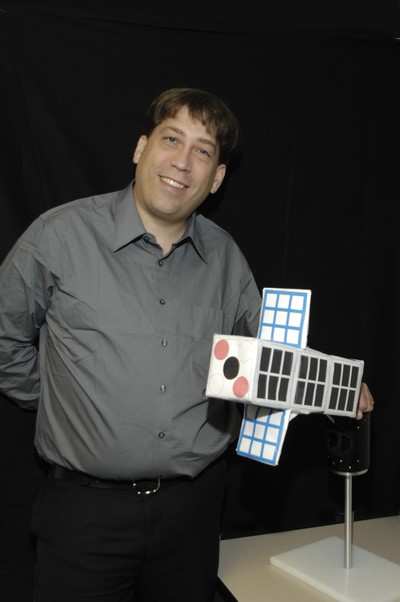Spacecraft Reports It Is 'Healthy' And Ready To Get To Work
A NASA team made first contact with the National Science Foundation-funded Firefly spacecraft at 1933 EST on Jan. 6, 2014. On the first pass, the team – based out of NASA's Wallops Flight Facility, Wallops Island, VA – received enough data to show that the spacecraft was healthy and transmitting a strong signal.

The data volumes on the spacecraft had been filled, as expected, given that the spacecraft had been downloading data since launch on Nov 19, 2013. When the team downlinked the first installment of the data, they found that the spacecraft power system is healthy and the computer processing unit temperature is within a good range, at about 50 F. The team will soon begin work to download the rest of the data, assess Firefly’s status, and then move the spacecraft into science mode.
The Firefly satellite was aboard the successful Defense Department ORS-3 mission that launched on Nov. 19, 2013 from NASA Wallops Flight Facility, Wallops Island, VA. The Firefly deployer was activated at the correct time, and automatic beacons from other nano-satellites in the same deployment wafer have been detected. Firefly does not have an automatic beacon mode, however, so the team will attempt to make contact as it passes over Wallops on Nov. 21 following the release of updated orbital information from the DOD.
Somewhere on Earth, there's always a lightning flash. The globe experiences lightning some 50 times a second, yet the details of what initiates this common occurrence and what effects it has on the atmosphere – lightning may be linked to incredibly powerful and energetic bursts called terrestrial gamma ray flashes, or TGFs -- remains a mystery. In mid-November, a football-sized mission called Firefly, which is funded by the National Science Foundation, will launch into space to study lightning and these gamma ray flashes from above.
The Firefly instrument is what's known as a CubeSat, a very small satellite that offers the chance for quality space science with a relatively inexpensive price tag. "We can do great science with these small missions," said Doug Rowland, the principal investigator for Firefly at NASA's Goddard Space Flight Center in Greenbelt, MD. "Firefly will gather up to a year of observations on the mysterious workings of lightning. Lightning is so familiar we tend to take it for granted, but we really don’t know the details of how it works — even though it is a critical part of the global electric circuit, and has obvious social and technological effects."
Lightning is ubiquitous and intimately connected to life on Earth, but we don't often think about what's happening higher up in the atmosphere. The radiation generated by lightning is so intense that it can generate antimatter and gamma rays within TGFs just a few miles of the ground. NASA's Compton Gamma Ray Observatory first discovered TGFs in the 1990s. Designed to look outward at cosmic sources of gamma rays, the mission also caught rare but tantalizing glimpses of gamma rays coming from Earth. "Gamma rays are thought to be emitted by electrons traveling at or near the speed of light when they're slowed down by interactions with atoms in the upper atmosphere," said Therese Moretto Jorgensen, program director in NSF's Division of Atmospheric and Geospace Sciences, which funds Firefly. "TGFs are among our atmosphere's most interesting phenomena."

The electrons needed to create gamma rays have to be moving so fast and carrying so much energy, that scientists were at a loss to explain what process near Earth could kick them up to such high speeds. Indeed, prior to the discovery of TGFs, scientists thought electrons moving this fast could only be generated near much larger bodies such as stars, galaxies or black holes.
Lightning by itself is thought to be only a tenth as strong as would be needed to accelerate the electron beams to such incredible speeds, but scientists have hypothesized that perhaps some lightning is triggered by an electron avalanche, a runaway chain reaction that pushes electrons up to these incredible speeds. Understanding the mechanism for what accelerates the electron beams near Earth will help scientists understand how the same process happens throughout the rest of the universe. "The idea that some of the lightning overhead may be triggered by the same processes that happen in supernovas and cosmic particle accelerators is mind-blowing," said Rowland. "I’ve never looked at thunderstorms the same way since learning about these ideas.”
The NSF CubeSat program represents a low cost access to space approach to performing high-quality, highly targeted science on a smaller budget than is typical of more comprehensive satellite projects, which have price tags starting at $100 million. The CubeSat Firefly, by focusing its science goals, will carry out its mission in a much smaller package and at a considerably lower cost.
(Artist's rendering provided by NASA)
 ANN's Daily Aero-Term (04.25.24): Airport Rotating Beacon
ANN's Daily Aero-Term (04.25.24): Airport Rotating Beacon ANN's Daily Aero-Linx (04.25.24)
ANN's Daily Aero-Linx (04.25.24) Klyde Morris (04.22.24)
Klyde Morris (04.22.24) Airborne 04.24.24: INTEGRAL E, Elixir USA, M700 RVSM
Airborne 04.24.24: INTEGRAL E, Elixir USA, M700 RVSM Airborne 04.22.24: Rotor X Worsens, Airport Fees 4 FNB?, USMC Drone Pilot
Airborne 04.22.24: Rotor X Worsens, Airport Fees 4 FNB?, USMC Drone Pilot




